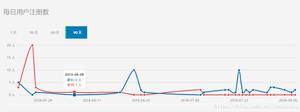R间隔,持续时间和期间
示例
间隔是在润滑物中记录时间跨度的最简单方法。间隔是两个特定时刻之间发生的时间跨度。
# create interval by substracting two instantstoday_start <- ymd_hms("2016-07-22 12-00-00", tz="IST")
today_start
## [1] "2016-07-22 12:00:00 IST"
today_end <- ymd_hms("2016-07-22 23-59-59", tz="IST")
today_end
## [1] "2016-07-22 23:59:59 IST"
span <- today_end - today_start
span
## Time difference of 11.99972 hours
as.interval(span, today_start)
## [1] 2016-07-22 12:00:00 IST--2016-07-22 23:59:59 IST
# create interval using interval() function
span <- interval(today_start, today_end)
[1] 2016-07-22 12:00:00 IST--2016-07-22 23:59:59 IST
持续时间可衡量两个瞬间之间发生的确切时间。
duration(60, "seconds")## [1] "60s"
duration(2, "minutes")
## [1] "120s (~2 minutes)"
注意:大于周的单位由于可变性而不会使用。
持续时间可以通过创建dseconds,dminutes以及持续时间等辅助功能。
运行?quick_durations完整列表。
dseconds(60)## [1] "60s"
dhours(2)
## [1] "7200s (~2 hours)"
dyears(1)
## [1] "31536000s (~365 days)"
可以减去持续时间并将其添加到瞬间以获得新的瞬间。
today_start + dhours(5)## [1] "2016-07-22 17:00:00 IST"
today_start + dhours(5) + dminutes(30) + dseconds(15)
## [1] "2016-07-22 17:30:15 IST"
可以从间隔创建持续时间。
as.duration(span)[1] "43199s (~12 hours)"
周期测量两个时刻之间发生的时钟时间变化。
期间可以使用创建period功能以及其他辅助功能,如seconds,hours等要得到的时期辅助功能的完整列表,运行?quick_periods。
period(1, "hour")## [1] "1H 0M 0S"
hours(1)
## [1] "1H 0M 0S"
period(6, "months")
## [1] "6m 0d 0H 0M 0S"
months(6)
## [1] "6m 0d 0H 0M 0S"
years(1)
## [1] "1y 0m 0d 0H 0M 0S"
is.period 函数可用于检查对象是否为句点。
is.period(years(1))## [1] TRUE
is.period(dyears(1))
## [1] FALSE
以上是 R间隔,持续时间和期间 的全部内容, 来源链接: utcz.com/z/353346.html



